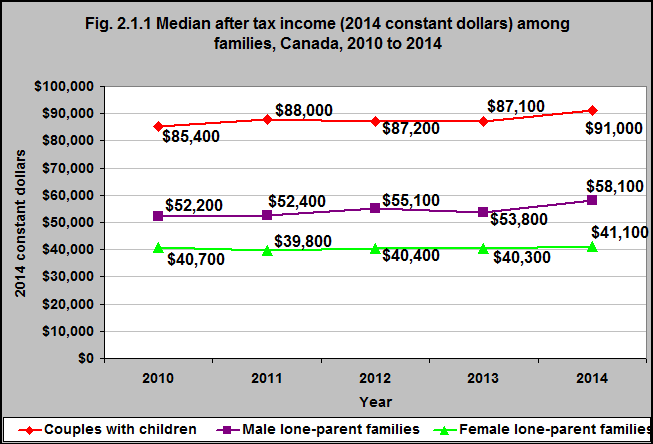Median after-tax income (2014 constant dollars) among families, Canada, 2010 to 2014

Source: CICH graphic created from data adapted from Statistics Canada. Table 206-0011- Market income, government transfers, total income, income tax and after-tax income, by economic family type, Canada, provinces and selected census metropolitan areas (CMAs), annual. http://www5.statcan.gc.ca/cansim/a26?lang=eng&retrLang=eng&id=2060011&&pattern=&stByVal=1&p1=1&p2=31&tabMode=dataTable&csid= – accessed July 12, 2017.
Between 2010 and 2014, Canadian couples with children saw their median after-tax income* increase by 6.6% to $91,000.
Male-led lone-parent families saw an increase in median after-tax income of 11.3% to $58,100.
Female-led lone-parent families only saw a 1% increase in median after-tax income to $41,000.
*The concept of income covers income received while a resident of Canada or as relevant for income tax purposes in Canada. Market income is the sum of earnings (from employment and net self-employment), net investment income, private retirement income, and the items under other income. It is also called income before taxes and transfers. Total income refers to income from all sources including government transfers and before deduction of federal and provincial income taxes. It may also be called income before tax (but after transfers). After-tax income is total income less income tax. It may also be called income after tax. The median is the level of income at which half the population has higher income and half has lower
Implications
Income is considered by many to be the most important social determinant of health. While families in Canada with children have seen their median after tax income increase in recent years – not all families have shared equally in that progress. Families with young children are particularly at risk for low income, and vulnerable to its negative effects. Children from families with the lowest incomes are, in general, at the greatest risk.1 They experience, for example, higher levels of health and behavioural problems.2
1Campaign 2000. 2016 Report Card on Child and Family Poverty in Canada. http://campaign2000.ca/wp-content/uploads/2016/11/Campaign2000NationalReportCard2016Eng.pdf – accessed June 20, 2017.
2Anderson Moore K, Redd Z, Burkhauser M, Mbwana K, Collins A. Children in Poverty: Trends, Consequences and Policy options. Child Trends Research Brief. 2009. https://www.childtrends.org/wp-content/uploads/2013/11/2009-11ChildreninPoverty.pdf – accessed June 20, 2017.
